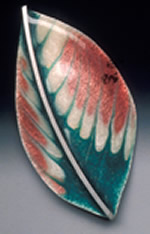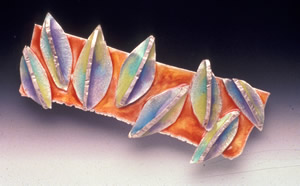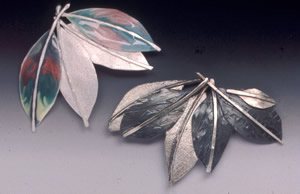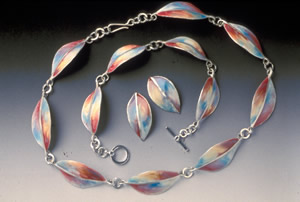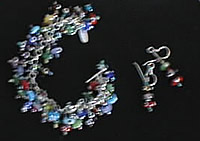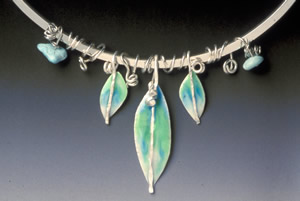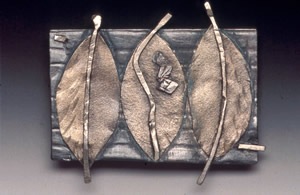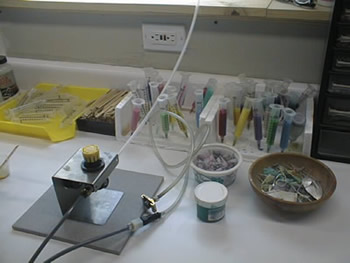The Artist as Entrepreneur |
Ellen
Klamon
|
The following is an interview with Ellen Klamon conducted by Barb Flowers, UM-St. Louis, in July 2004. The conversation began with a discussion of Ellen's preferred medium and her educational background. Q. You seem fond of your Maryville days. Tell me about your college experience. A. I had been a hippie, so I started Maryville in my mid-twenties. I went to Maryville because, well, I don’t know how much you want to know about this, but I went to Mizzou, and I got myself kicked out of there. It was during the Kent State strikes. I came back to Meramec and was having a hard time settling down, so I left. I really was a hippie. I traveled across the country and did all kinds of things. And then I had had it, and came back. Maryville, truthfully, was one of the few schools that took me, and they gave me a full scholarship, including room and board, which was great. It was a good opportunity for me because I was a big fish in a small pond. Q. Did you pick up things in your travels about the kind of work that you wanted to do? A. Well, I always wanted to be an artist. The problem was, my parents wouldn’t let me. They thought I would never make a living, and I should go into computers. Actually, they were probably right. (laugh) But that wasn’t what I wanted to do, and, in fact, when I went to Mizzou, I was in occupational therapy – the closest work, I figured, where I could make a living using some kind of art. I don’t know what kind of counseling the high school kids get now, in terms of careers, but nobody told me I could make a living as a graphic artist or an illustrator. I didn’t know those things existed. I thought you either were a painter or you weren’t. Q. Did you have art classes as a child? A. You know how kids get pegged? I was the artist in the class, and my parents actually gave me some private art classes. There was an artist who lived down the street, and she taught in her home. So, I knew I wanted to be an artist; I just didn’t know what I wanted to do with it. I didn’t have that kind of counseling, nor did my parents. My high school counselors provided no advice. If I had known about illustrating, I probably would have gone into it because drawing really is my forte.
Q. That’s what we’ve heard while conducting these interviews. We have also found that artists don’t start off their career on their own, but later move into their own business. A. Well, a lot of artists start out as teachers or as waitresses. I’m sure it’s like the Hollywood people – you’ve got to make your living somehow. Q. When did you actually enter into this business? A. In college, my degree was in printmaking. I did serigraph, which are silk screens. It was the '70s, and silk screens were kind of “in.” While I was in college, I started doing these outdoor shows, which was discouraged by the school because, in the '70s, you were supposed to just paint from your heart and not worry about how you would make a living. So, I started to present my prints at shows, and that was rough.
Q. You had mentioned that your family was not very supportive of your pursuing this as a career. How did your friends react? Were you surrounded by artist friends? A. Well, my own friends from school were not artists – I was the artist of the group. But, once you get into this field, you begin to meet people. Most of my friends from that group are artists. Within your field, you get to know other printmakers, or you get to know other jewelers. Q. Are there things you’ve had to sacrifice to pursue this career? A. Truthfully, I can’t imagine doing anything else. The problem with having other jobs is that it drains you. If you're waitressing, or you're bagging groceries, or teaching, all of your energies go into that other job, and it takes a lot to have some energy left at the end of the evening to do your artwork. If you choose to do the show circuit, most of your weekends are tied up with that, so I think it is hard. The interesting thing is that on the show circuit, all of the artists are in their 50s. You don’t see young people go into this. I’m not sure why. It might be that we’re all sort of left-over hippies with the vagabond sort of mentality. It could also be that the young people going into this see that it’s a lot of hard work without a lot of return, so maybe there are other ways they are finding to make money. And, another thing, is that some people have retired and are on their second careers, and they’re going to do what they want to do, although the majority have been doing this for 20 or 30 years.
A. There is a dichotomy for me in terms of making the art and selling the art. I’m not a salesperson. I’m not a promoter. I’m not a marketer, and you have to do all those things. So that’s where I have my hard time. I can do the paperwork; I can have a system set up for me. Marketing is difficult and time-consuming. For instance, I’ve been trying to pull a website together for six months. I have to get all my things photographed. The business of art is a lot more involved than you would think. Sometimes I resent that part of it.
Q. What other avenues are there? A. You can get a person to represent you, of course then you’re giving him a percentage. You could put things in the galleries or shops and have them sell for you, but there’s still a business aspect that has to be dealt with, and that’s where I think the colleges and universities fall short. They need to be showing these kids how to self-promote – how to put together a resume, how to get your slides ready, how to approach a gallery, what to expect, and how to follow through. You have to decide on a gallery, you have to send your work out. If you have your things on consignment, you have to continue to monitor that. Those skills are usually alien to the artistic mind and are not taught at universities. Q. If your children told you they were planning a career in art, what advice would you give them?
Q. Does she draw? A. Yes. Q. Does she draw all the time? A. No, she doesn’t, and truthfully I don’t know anybody who does that. I remember as a kid watching movies about Michelangelo and Leonardo Da Vinci, and they were drawing constantly – always, always, always. I dated a man who would carry sketch books with him, but he was the only person I know of who did that. I think the artistic mind is working all the time. When I walk to somebody’s house or if I go inside, I’m studying how I would do something differently, how I would change this or rearrange that. A lot of my jewelry is nature-related, and so I’m absorbing the environment all the time. I think in many ways my mind is working overtime, but in terms of actually drawing, that’s not a constant activity for me. When I went to art school, I'd had a lot of art lessons; I had art in high school. I was exposed to art. I came to art school with some background. I actually submitted a portfolio in order to get my scholarship. I saw these kids come in who really hadn’t had any art training at all, but they had some sort of drive or want. They might not have been all that talented, but they had determination, and they worked hard, and by the time they graduated, I was impressed. Determination often overcomes that lack of spark. Q. Do you think that somebody who lacks that sort of innate artistic talent can be successful? A. Absolutely. It’s like anything else, you practice the piano everyday and you really want to succeed, you will be pretty good. Now, you may not be Van Cliburn, but it’s like a craft. I think we’re all capable of all kinds of things, it just depends on what your interest level is. Q. So, your advice, if you really feel like you have that want, regardless of what anybody has said to you, is that you should just do it. A. Absolutely. There is creativity in everything you do. For instance, your son is now doing woodworking; my daughter’s doing hairdressing. You can be creative about your approach to anything. It doesn’t have to be art. Q. Are you wearing your work? A. Actually, I’m not. One of the advantages to being in these art shows is that we all trade – especially in down times when there’s nobody else buying. Q. When you do the circuit, obviously there are some fairs that are better than others. Are you allowed into any fair that you want? How does that work?
I work as a juror coordinator for two organizations, and this is the way it works. The slides come in, usually it’s four slides of your work and one of your booth or display. A panel of jurors will use four or five slide projectors to view all of your slides at one time. The slide presentations are anonymous.
Q. Do you find that you see the same artists at shows because they are of a certain caliber? A. They are high caliber. But, each particular show has a thrust that they are looking for. For instance, the Laumeier show here is usually looking for whimsical, sort of fun mid- to upper-range priced things. The Clayton show is very high-end and looking for people in that grouping. And there are different categories of all of these shows. You can go to a show at the Kirkwood Community Center for $25, get a table and put your stuff out. Some of the shows cost $500 to $2,000 to get a booth. Q. I’m familiar with Westport and Shaw. Would they be considered mid-level, more local, or what? A. The Shaw show has a very good reputation. It’s a very small show. There are only about 100 artists, so it’s harder to get into. The Westport show is a more mid-range, show. It's run by a show promoter, Joyce Rosen. She does that, and she does the St. Charles show, and she’s now the head of The Foundry in St. Charles. Have you seen that? You’ll have to put that on your list. This has just started. It is a building that was originally a factory or something and it’s on Main Street, there on the river. I think they have 24 artists' studios there, and they have a gallery and classrooms. I don’t know how she does all of it. Q. I'll have to take trip out there. It would be fascinating to see so many artist studios in one place. A. Have you ever seen the Torpedo Factory in Alexandria, Virginia? It’s the coolest thing. There are something like three floors of artist studios. Each studio is divided into a working area in the back and a retail area in the front. So you can buy their wares there. The Foundry is based on that concept, although I don’t think it functions quite that way. It’s divided up into one-room studios, and I don’t think there is show space. I think there is a gallery downstairs, but I don’t know all of the particulars. It’s pretty swell. I don’t know anything about what it costs or how it works. It’s fairly new. Q. I see your paintings on the wall in this room. Is there anything else of yours in here? A. The ceramics are mine from college. Most of the artwork is mine. Q. Did you start out as a potter? A. I went to Maryville as a painter. I didn’t particularly care for the painting instructor but got excited about printmaking when I discovered it. I was just so excited about it – clear, bright colors that you could just put out and you got multiples right away. It was an exciting, fast medium for me, but it was very unhealthy. Silk screening is just awful for your health. Most art is. Ceramics is particularly awful. In fact, we had a friend whom we started out with who died from lung cancer because of the ceramics. You get this disease called silicosis because you're breathing in all of the dust from the clay itself and then from the chemicals that are put on the glazes. With jewelry, there are all kinds of fumes that come off the soldering, and I work with epoxy – that’s pretty nasty stuff. With silk screening, you’re working with lacquer thinners. It’s awful. When I think about it now, art studios in school were in the basement of a building, and there was no ventilation, no outside air. All of these kids were using these lacquer thinners. It was shocking – it was awful. And half of us smoked, of course, this was in the '70s. I gave up silk screening because it was just so bad, and also, for whatever reason, it died out. But I still like the printmaking medium. These are hand-colored linoleum prints [on the wall]. Q. I’m really ignorant of this. How is this done? A. You can tell when I begin to show it to you that the block is 4" x 4". I carve the image into the block, print it in black, and color the prints using colored pencils. Then, I turn it in many directions. So this is a single image in a row. These over here are the same images in wood. These are all from a series that I did. Q. I can see some similarities in the drawings, but I’m just not seeing the repeated pattern. I just don’t see things like that until they are pointed out. A. Well, that’s a good thing because I want you to see them differently. I love to draw. I still do drawings. I had breast cancer - breast cancer and divorce all at the same time. Let me tell you, that was the worst point in my life. After that, I had a one-woman show - just drawings of what I had gone through. Half of the drawings were botanical because I felt I was entering a new life. The other half were just clear, bright colors. That’s where I get my energy – through the color. When I show you the jewelry – it’s colorful. Q. I’m eager to see it. (Ellen gave me a tour of her studio.) A. This is the bench area. I don’t work like most jewelers. They sit at the bench and do all of their work there. I get up and move around. I think it’s partially because I'm from a different orientation than a bench jeweler. I have a friend who works here occasionally. This is his desk, and he literally will sit there and never get up. This is his soldering machine, so he can just sit here and never move. He was trained as a bench jeweler, that is, a person who does repair work at a jewelry store, which is excellent training. I don’t have that kind of training. Q. How do you begin a new piece?
A. I was looking for a way to put color onto my jewelry, other than stones, so I tried enameling. That was a pretty involved process. I knew it wasn’t for me – too involved and too chemical. I discovered this epoxy thing. There aren’t many people who do it, and I think I have perfected this particular method. Q. Epoxy is glue isn’t it? A. It is, literally, as you get it in the hardware store. You have a resin and a hardener, and the colorant is added to the resin. I use a scale because the mixture of resin and hardener must be precise. Once it's mixed, I have 40 minutes to work on it before it starts to set up. So I can only mix it in small batches. Ellen Klamon's studio is in her home. Part of the studio area is being remodeled into a classroom where she will provide art lessons for children - much like her own experience as a child. copyright 2004, Center for Entrepreneurship and Economic Education, University of Missouri-St. Louis
|
